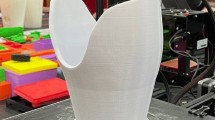The use of 3D printing in orthopedics has several advantages, one of which is a reduction of the implant weight due to the use of honeycomb structures. In this work, a technique for making a 3D-printed shoulder implant lighter without compromising its rigidity and strength is suggested. Comparative analysis of the stress–strain state of a shoulder implant has been carried out for two modifications of the implant: solid and honeycomb (lightweight). The first (solid single-piece) implant has been manufactured using conventional technologies; the second (lightweight honeycomb), by 3D printing. The honeycomb implant has been shown to exhibit the same strength as its solid counterpart, which makes it safe for orthopedic use.
Similar content being viewed by others

References
Sanchez-Sotelo, J., Cofield, R. H., and Rowland, C. M., “Shoulder hemiarthroplasty for glenohumeral arthritis associated with severe rotator cuff deficiency,” JBJS, 83, No. 12, 1814-1822 (2001).
Fuhrmann, R. A., Roth, A., and Venbrocks, R. A., “Salvage of the upper extremity in cases of tumorous destruction of the proximal humerus,” J. Cancer Res. Clin. Oncol., 126, No. 6, 337-344 (2000).
Rodl, R. W. et al., “Reconstruction of the proximal humerus after wide resection of tumours,” J. Bone Joint Surg. Brit. Vol., 84, No. 7, 1004-1008 (2002).
Van de Sande, M. A. J., Dij kstra, P. D., and Taminiau, A. H. M., “Proximal humerus reconstruction after tumour resection: Biological versus endoprosthetic reconstruction,” Int. Orthopaed., 35, No. 9, 1375-1380 (2011).
Mok, S. W. et al., “From the printer: Potential of three-dimensional printing for orthopaedic applications,” J. Orthopaed. Transl., 6, 42-49 (2016).
Pearl, M. L., “Proximal humeral anatomy in shoulder arthroplasty: Implications for prosthetic design and surgical technique,” J. Shoulder Elbow Surg., 14, No. 1, 99-104 (2005).
Peretyaka, A. P. and Maykov, S. V., “Results of primary and revision reverse shoulder arthroplasty,” Traumatol. Orthoped. Russ., 18, No. 4, 93-98 (2012).
Murylev, V., Elizarov, P., Lychagin, A., Rukin, Ya., Muzychenkov, A., and Rubin, G., “Experience with endoprosthetic shoulder joint replacement with different implants,” The Doctor, 1, 61-66 (2016).
D’Arienzo, A., Ipponi, E., Ruinato, A.D., De Franco, S., Colangeli, S., Andreani, L., and Capanna, R., “Proximal humerus reconstruction after tumor resection: An overview of surgical management,” Adv. Orthoped., 2021, 16 (2021).
Sufiiarov, V. S. et al., “Design and mechanical properties simulation of graded lattice structures for additive manufacturing endoprostheses,” Mech. Adv. Mat. Struct., 28, No. 16, 1656-1662 (2021).
Li, Z., Wang, C., Li, C., Wang, Z., Yang, F., Liu, H., Qin, Y., and Wang, J., “What we have achieved in the design of 3D printed metal implants for application in orthopedics? Personal experience and review,” Rapid Prototyp. J., 24, No. 8, 1365-1379 (2018).
Kohlhof, H. et al., “Reconstruction of tibial metaphyseal defects with artificial components in revision arthroplasty (GenuX MK System),” Operative Orthopadie und Traumatologie, 32, No. 4, 284-297 (2020).
Javaid, M. and Haleem, A., “Additive manufacturing applications in medical cases: A literature based review,” Alexandria J. Med., 54, No. 4, 411-422 (2018).
Mroczkowski, M. and Wilex, M., Initial Fixation of the Trabecular Metal Reverse Shoulder Glenoid Base Implant, Zimmer (2008).
Liu, Y., Rath, B., Tingart, M., and Eschweiler, J., “Role of implants surface modification in osseointegration: A systematic review,” J. Biomed. Mat. Res. Part A, 108, No. 3, 470-484 (2020).
Fradique, R. et al., “Production of new 3D scaffolds for bone tissue regeneration by rapid prototyping,” J. Mat. Sci.: Mat. Med., 27, No. 4, 1-14 (2016).
Shevtsov, M., Gavrilov, D., Yudintceva, N., Zemtsova, E., Arbenin, A., Smirnov, V., Voronkina, I., Adamova, P., Blinova, M., Mikhailova, N. et al., “Protecting the skin-implant interface with transcutaneous silver-coated skin-and-bone-integrated pylon in pig and rabbit dorsum models,” J. Biomed. Mat. Res. Part B: Appl. Biomat., 109, No. 4, 584-595 (2021).
Zhang, B. G. X. et al., “Bioactive coatings for orthopaedic implants – Recent trends in development of implant coatings,” Int. J. Mol. Sci., 15, No. 7, 11878-11921 (2014).
Albrektsson, T. and Johansson, C., “Osteoinduction, osteoconduction and osseointegration,” Europ. Spine J., 10, No. 2, 96-101 (2001).
Narra, S. P. et al., “Additive manufacturing in total joint arthroplasty,” Orthoped. Clin. North Amer., 50, No. 1, 13 (2019).
Wodarski, P. et al., “Wyznaczanie obciążeń w stawie ramiennym z wykorzystaniem przestrzennego matematycznego modelu kończyny gornej,” Modelowanie Inżynierskie, 29, No. 60, 74-79 (2016).
Dumas, M., Terriault, P., and Brailovski, V., “Modelling and characterization of a porosity graded lattice structure for additively manufactured biomaterials,” Mat, Design, 121, 383-392 (2017).
Limmahakhun, S., Oloyede, A., Sitthiseripratip, K., Xiao, Y., and Yan, C., “3D-printed cellular structures for bone biomimetic implants,” Add. Manufact., 15, 93-101 (2017).
Simoes, J. A. and Marques, A. T., “Design of a composite hip femoral prosthesis,” Mat. Design., 26, No. 5, 391-401 (2005).
Author information
Authors and Affiliations
Corresponding author
Additional information
Translated from Meditsinskaya Tekhnika, Vol. 56, No. 3, May-Jun., 2022, pp. 33-36.
Rights and permissions
Springer Nature or its licensor holds exclusive rights to this article under a publishing agreement with the author(s) or other rightsholder(s); author self-archiving of the accepted manuscript version of this article is solely governed by the terms of such publishing agreement and applicable law.
About this article
Cite this article
Sinegub, A.V., Suvorov, V.A., Gavrilov, D.V. et al. Comparative Analysis of the Stress–Strain State of a Lightweight 3D-Printed Shoulder Implant. Biomed Eng 56, 194–197 (2022). https://doi.org/10.1007/s10527-022-10196-1
Received:
Published:
Issue Date:
DOI: https://doi.org/10.1007/s10527-022-10196-1



